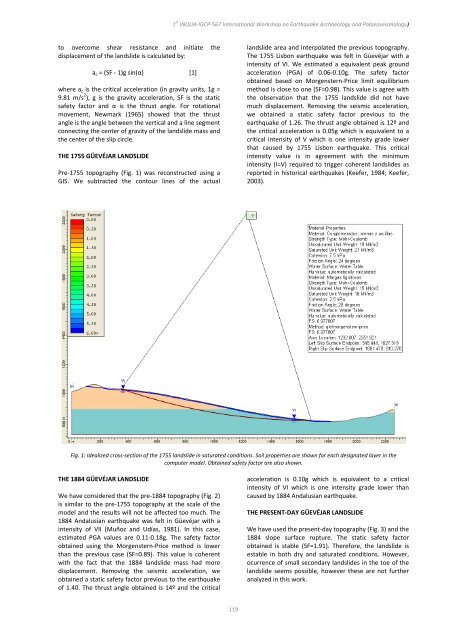Archaeoseismology and Palaeoseismology in the Alpine ... - Tierra
Archaeoseismology and Palaeoseismology in the Alpine ... - Tierra
Archaeoseismology and Palaeoseismology in the Alpine ... - Tierra
Create successful ePaper yourself
Turn your PDF publications into a flip-book with our unique Google optimized e-Paper software.
to overcome shear resistance <strong>and</strong> <strong>in</strong>itiate <strong>the</strong><br />
displacement of <strong>the</strong> l<strong>and</strong>slide is calculated by:<br />
ac = (SF ‐ 1)g s<strong>in</strong>(α) [1]<br />
where ac is <strong>the</strong> critical acceleration (<strong>in</strong> gravity units, 1g =<br />
9.81 m/s 2 ), g is <strong>the</strong> gravity acceleration, SF is <strong>the</strong> static<br />
safety factor <strong>and</strong> α is <strong>the</strong> thrust angle. For rotational<br />
movement, Newmark (1965) showed that <strong>the</strong> thrust<br />
angle is <strong>the</strong> angle between <strong>the</strong> vertical <strong>and</strong> a l<strong>in</strong>e segment<br />
connect<strong>in</strong>g <strong>the</strong> center of gravity of <strong>the</strong> l<strong>and</strong>slide mass <strong>and</strong><br />
<strong>the</strong> center of <strong>the</strong> slip circle.<br />
THE 1755 GÜEVÉJAR LANDSLIDE<br />
Pre‐1755 topography (Fig. 1) was reconstructed us<strong>in</strong>g a<br />
GIS. We subtracted <strong>the</strong> contour l<strong>in</strong>es of <strong>the</strong> actual<br />
1 st INQUA‐IGCP‐567 International Workshop on Earthquake Archaeology <strong>and</strong> <strong>Palaeoseismology</strong>)<br />
119<br />
l<strong>and</strong>slide area <strong>and</strong> <strong>in</strong>terpolated <strong>the</strong> previous topography.<br />
The 1755 Lisbon earthquake was felt <strong>in</strong> Güevéjar with a<br />
<strong>in</strong>tensity of VI. We estimated a equivalent peak ground<br />
acceleration (PGA) of 0.06‐0.10g. The safety factor<br />
obta<strong>in</strong>ed based on Morgenstern‐Price limit equilibrium<br />
method is close to one (SF=0.98). This value is agree with<br />
<strong>the</strong> observation that <strong>the</strong> 1755 l<strong>and</strong>slide did not have<br />
much displacement. Remov<strong>in</strong>g <strong>the</strong> seismic acceleration,<br />
we obta<strong>in</strong>ed a static safety factor previous to <strong>the</strong><br />
earthquake of 1.26. The thrust angle obta<strong>in</strong>ed is 12º <strong>and</strong><br />
<strong>the</strong> critical acceleration is 0.05g which is equivalent to a<br />
critical <strong>in</strong>tensity of V which is one <strong>in</strong>tensity grade lower<br />
that caused by 1755 Lisbon earthquake. This critical<br />
<strong>in</strong>tensity value is <strong>in</strong> agreement with <strong>the</strong> m<strong>in</strong>imum<br />
<strong>in</strong>tensity (I=V) required to trigger coherent l<strong>and</strong>slides as<br />
reported <strong>in</strong> historical earthquakes (Keefer, 1984; Keefer,<br />
2003).<br />
Fig. 1: Idealized cross‐section of <strong>the</strong> 1755 l<strong>and</strong>slide <strong>in</strong> saturated conditions. Soil properties are shown for each designated layer <strong>in</strong> <strong>the</strong><br />
computer model. Obta<strong>in</strong>ed safety factor are also shown.<br />
THE 1884 GÜEVÉJAR LANDSLIDE<br />
We have considered that <strong>the</strong> pre‐1884 topography (Fig. 2)<br />
is similar to <strong>the</strong> pre‐1755 topography at <strong>the</strong> scale of <strong>the</strong><br />
model <strong>and</strong> <strong>the</strong> results will not be affected too much. The<br />
1884 Andalusian earthquake was felt <strong>in</strong> Güevéjar with a<br />
<strong>in</strong>tensity of VII (Muñoz <strong>and</strong> Udías, 1981). In this case,<br />
estimated PGA values are 0.11‐0.18g. The safety factor<br />
obta<strong>in</strong>ed us<strong>in</strong>g <strong>the</strong> Morgenstern‐Price method is lower<br />
than <strong>the</strong> previous case (SF=0.89). This value is coherent<br />
with <strong>the</strong> fact that <strong>the</strong> 1884 l<strong>and</strong>slide mass had more<br />
displacement. Remov<strong>in</strong>g <strong>the</strong> seismic acceleration, we<br />
obta<strong>in</strong>ed a static safety factor previous to <strong>the</strong> earthquake<br />
of 1.40. The thrust angle obta<strong>in</strong>ed is 14º <strong>and</strong> <strong>the</strong> critical<br />
acceleration is 0.10g which is equivalent to a critical<br />
<strong>in</strong>tensity of VI which is one <strong>in</strong>tensity grade lower than<br />
caused by 1884 Andalusian earthquake.<br />
THE PRESENT‐DAY GÜEVÉJAR LANDSLIDE<br />
We have used <strong>the</strong> present‐day topography (Fig. 3) <strong>and</strong> <strong>the</strong><br />
1884 slope surface rupture. The static safety factor<br />
obta<strong>in</strong>ed is stable (SF=1.91). Therefore, <strong>the</strong> l<strong>and</strong>slide is<br />
estable <strong>in</strong> both dry <strong>and</strong> saturated conditions. However,<br />
ocurrence of small secondary l<strong>and</strong>slides <strong>in</strong> <strong>the</strong> toe of <strong>the</strong><br />
l<strong>and</strong>slide seems possible, however <strong>the</strong>se are not fur<strong>the</strong>r<br />
analyzed <strong>in</strong> this work.



